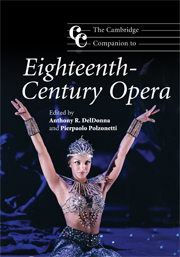Book contents
- Frontmatter
- Part I The making of opera
- 1 Opera as process
- 2 Aria as drama
- 3 Ensembles and finales
- 4 Metastasio: the dramaturgy of eighteenth-century heroic opera
- 5 Roles and acting
- 6 Ballet
- 7 Orchestra and voice in eighteenth-century Italian opera
- 8 To look again (at Don Giovanni)
- Part II National styles and genres
- Notes
- Bibliography
- Index
6 - Ballet
from Part I - The making of opera
Published online by Cambridge University Press: 28 September 2011
- Frontmatter
- Part I The making of opera
- 1 Opera as process
- 2 Aria as drama
- 3 Ensembles and finales
- 4 Metastasio: the dramaturgy of eighteenth-century heroic opera
- 5 Roles and acting
- 6 Ballet
- 7 Orchestra and voice in eighteenth-century Italian opera
- 8 To look again (at Don Giovanni)
- Part II National styles and genres
- Notes
- Bibliography
- Index
Summary
During the eighteenth century, a night at the opera almost always included ballet. Such a fundamental fact of life in the eighteenth century is so far removed from our own experience of opera that its reality is easy to overlook, yet it was the case across Europe, even in Italy. Opera audiences anticipated spending part of every evening watching dancers, but depending on where they lived, they had differing expectations as to what they would see and how the dancing fit (or not) into the opera. In France dancing was structured into every act of every opera. In Italy ballets were performed between the acts and only rarely made connection with the plot of the opera. England and the German-speaking areas tended to follow the Italian model, but with local variations. The presence of so much dancing meant that opera houses supported dancers as well as singers. Even today, many European opera houses have a dance troupe, although the functions of ballet and opera have increasingly grown apart.
France
The French operatic model was created in the late seventeenth century by Jean-Baptiste Lully and his primary librettist, Philippe Quinault, who wrote twelve works together between 1672 and 1686. The conventions they established, including the integration of dance into each opera, prevailed throughout the eighteenth century as well. In Lullian opera the dancers function in essence as part of the chorus, some of whom sing, others of whom dance. Every act includes at least one scene that brings large groups of people on stage, in musically and visually sumptuous scenes that came to be called “divertissements.”
- Type
- Chapter
- Information
- The Cambridge Companion to Eighteenth-Century Opera , pp. 99 - 111Publisher: Cambridge University PressPrint publication year: 2009



